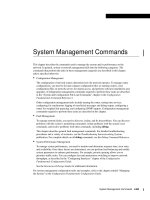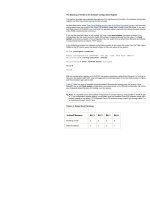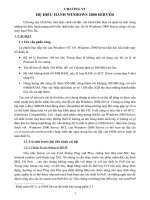Tài liệu Quản trị mang Subnet Zero and All-Ones Subnet
Bạn đang xem bản rút gọn của tài liệu. Xem và tải ngay bản đầy đủ của tài liệu tại đây (18.9 KB, 7 trang )
Subnet Zero and the All−Ones Subnet
Table of Contents
Subnet Zero and the All−Ones Subnet..............................................................................................................1
Introduction..............................................................................................................................................1
Subnet Zero..............................................................................................................................................1
The All−Ones Subnet...............................................................................................................................2
Problems with Subnet Zero and the All−Ones Subnet............................................................................2
Subnet−Zero...............................................................................................................................2
The All−Ones Subnet.................................................................................................................3
Using Subnet Zero and the All−Ones Subnet..........................................................................................4
Related Information.................................................................................................................................5
Subnet Zero and the All−Ones Subnet
i
Subnet Zero and the All−Ones Subnet
Introduction
Subnet Zero
The All−Ones Subnet
Problems with Subnet Zero and the All−Ones Subnet
Subnet Zero
The All−Ones Subnet
Using Subnet Zero and the All−Ones Subnet
Related Information
Introduction
Subnetting breaks down a given network address into smaller subnets. It allows for the more efficient use of
available IP address space, in tandem with other technologies like Network Address Translation (NAT) and
Port Address Translation (PAT), thereby alleviating the problem of address depletion to a great extent.
Subnetting has guidelines regarding the use of the first and the last subnets, known as subnet zero and the
all−ones subnet, respectively. This document discusses subnet zero and the all−ones subnet and their uses.
Subnet Zero
If a network address is subnetted, the first subnet obtained after subnetting the network address is called
subnet zero.
Consider a Class B address, 172.16.0.0. By default the Class B address 172.16.0.0 has 16 bits reserved for
representing the host portion, thus allowing 65534 (2
16
−2) valid host addresses. If network 172.16.0.0/16 is
subnetted by borrowing three bits from the host portion, eight (2
3
) subnets are obtained. The table below is an
example showing the subnets obtained by subnetting the address 172.16.0.0, the resulting subnet mask, the
corresponding broadcast addresses, and the range of valid host addresses.
Subnet Address Subnet Mask Broadcast Address
Valid Host
Range
172.16.0.0 255.255.224.0 172.16.31.255
172.16.0.1 to
172.16.31.254
172.16.32.0 255.255.224.0 172.16.63.255
172.16.32.1 to
172.16.63.254
172.16.64.0 255.255.224.0 172.16.95.255
172.16.64.1 to
172.16.95.254
172.16.96.0 255.255.224.0 172.16.127.255
172.16.96.1 to
172.16.127.254
172.16.128.0 255.255.224.0 172.16.159.255
172.16.128.1 to
172.16.159.254
172.16.160.0 255.255.224.0 172.16.191.255
172.16.160.1 to
172.16.191.254
172.16.192.0 255.255.224.0 172.16.223.255
172.16.192.1 to
172.16.223.254
Subnet Zero and the All−Ones Subnet
172.16.224.0 255.255.224.0 172.16.255.255
172.16.224.1 to
172.16.255.254
In our example above, the first subnet, subnet 172.16.0.0/19, is called subnet zero.
Note that the class of the network subnetted and the number of subnets obtained after subnetting have
absolutely no role in determining subnet zero. It is simply the first subnet obtained when subnetting the
network address. Further, when you write the binary equivalent of the subnet zero address, all the subnet bits
(bits 17, 18, and 19 in this case) are zeros. Subnet zero is thus also known as the all−zeros subnet.
The All−Ones Subnet
When a network address is subnetted, the last subnet obtained is called the all−ones subnet.
With reference to the example above, the last subnet obtained when subnetting network 172.16.0.0, subnet
172.16.224.0/19, is called the all−ones subnet.
Note that the class of the network subnetted and the number of subnets obtained after subnetting have
absolutely no role in determining the all−ones Subnet. Also, when you write the binary equivalent of the
subnet zero address, all the subnet bits (bits 17, 18, and 19 in this case) are ones, hence the name.
Problems with Subnet Zero and the All−Ones Subnet
Traditionally, it was strongly recommended that subnet zero and the all−ones subnet not be used for
addressing. According to RFC 950 , "It is useful to preserve and extend the interpretation of these special
(network and broadcast) addresses in subnetted networks. This means the values of all zeros and all ones in
the subnet field should not be assigned to actual (physical) subnets." This is the reason why network engineers
required to calculate the number of subnets obtained by borrowing three bits would calculate 2
3
−2 (6) and not
2
3
(8). The "−2" takes into account that subnet zero and the all−ones subnet are not used traditionally.
Subnet−Zero
Use of subnet zero for addressing was discouraged because of the confusion inherent in having a network and
a subnet with indistinguishable addresses.
With reference to our example above, consider the IP address 172.16.1.10. Now, if you calculate the subnet
address corresponding to this IP address, the answer you would arrive at would be subnet 172.16.0.0 (subnet
zero). Note that this subnet address is identical to network address 172.16.0.0, which was subnetted in the first
place, so whenever you perform subnetting, you get a network and a subnet (subnet zero) with
indistinguishable addresses. This was formerly a source of great confusion.
Prior to Cisco IOS
®
Software Release 12.0, Cisco routers, by default, did not allow an IP address belonging to
subnet zero to be configured on an interface. However, if a network engineer working with Cisco IOS version
older than 12.0 finds it safe to use subnet zero, the ip subnet−zero command in the global configuration mode
can be used to overcome this restriction. As of Cisco IOS version 12.0, Cisco routers now have ip
subnet−zero enabled by default, but if the network engineer feels that it is unsafe to use subnet zero, the no ip
subnet−zero command can be used to restrict the use of subnet zero addresses.
In versions prior to Cisco IOS version 8.3, the service subnet−zero command was used.
Subnet Zero and the All−Ones Subnet
The All−Ones Subnet
Use of the all−ones subnet for addressing has been discouraged in the past because of the confusion inherent
in having a network and a subnet with identical broadcast addresses.
With reference to our example above, the broadcast address for the last subnet (subnet 172.16.224.0/19) is
172.16.255.255, which is identical to the broadcast address of the network 172.16.0.0, which was subnetted in
the first place, so whenever you perform subnetting you get a network and a subnet (all−ones subnet) with
identical broadcast addresses. In other words, a network engineer could configure the address 172.16.230.1/19
on a router, but if that is done, he can no longer differentiate between a local subnet broadcast
(172.16.255.255 (/19)) and the complete Class B broadcast (172.16.255.255(/16)).
Although the all−ones subnet can now be used, misconfigurations can cause problems. To give you an idea of
what can happen, consider the following:
Note: See Host and Subnet Quantities for details.
Routers 2 through 5 are access routers that each have several incoming asynchronous (or ISDN) connections.
We have decided to break up a network (195.1.1.0/24) into four pieces for these incoming users. Each piece is
given to one of the access routers. Also, the asynchronous lines are configured ip unnum e0. Router 1 has
static routes pointing at the correct access router, and each access router has a default route pointing at Router
1.
The Router 1 routing table looks like this:
C 195.1.2.0/24 E0
S 195.1.1.0/26 195.1.2.2
S 195.1.1.64/26 195.1.2.3
S 195.1.1.128/26 195.1.2.4
S 195.1.1.192/26 195.1.2.5
The access routers have the same connected route for the Ethernet, the same default route and several host
routes for their asynchronous lines (courtesy of Point−to−Point Protocol (PPP)).
Router 2 routing table: Router 3 routing table:
C 195.1.2.0/24 E0 C 195.1.2.0/24 E0
S 0.0.0.0/0 195.1.2.1 S 0.0.0.0/0 195.1.2.1
C 195.1.1.2/32 async1 C 195.1.1.65/32 async1
Subnet Zero and the All−Ones Subnet









